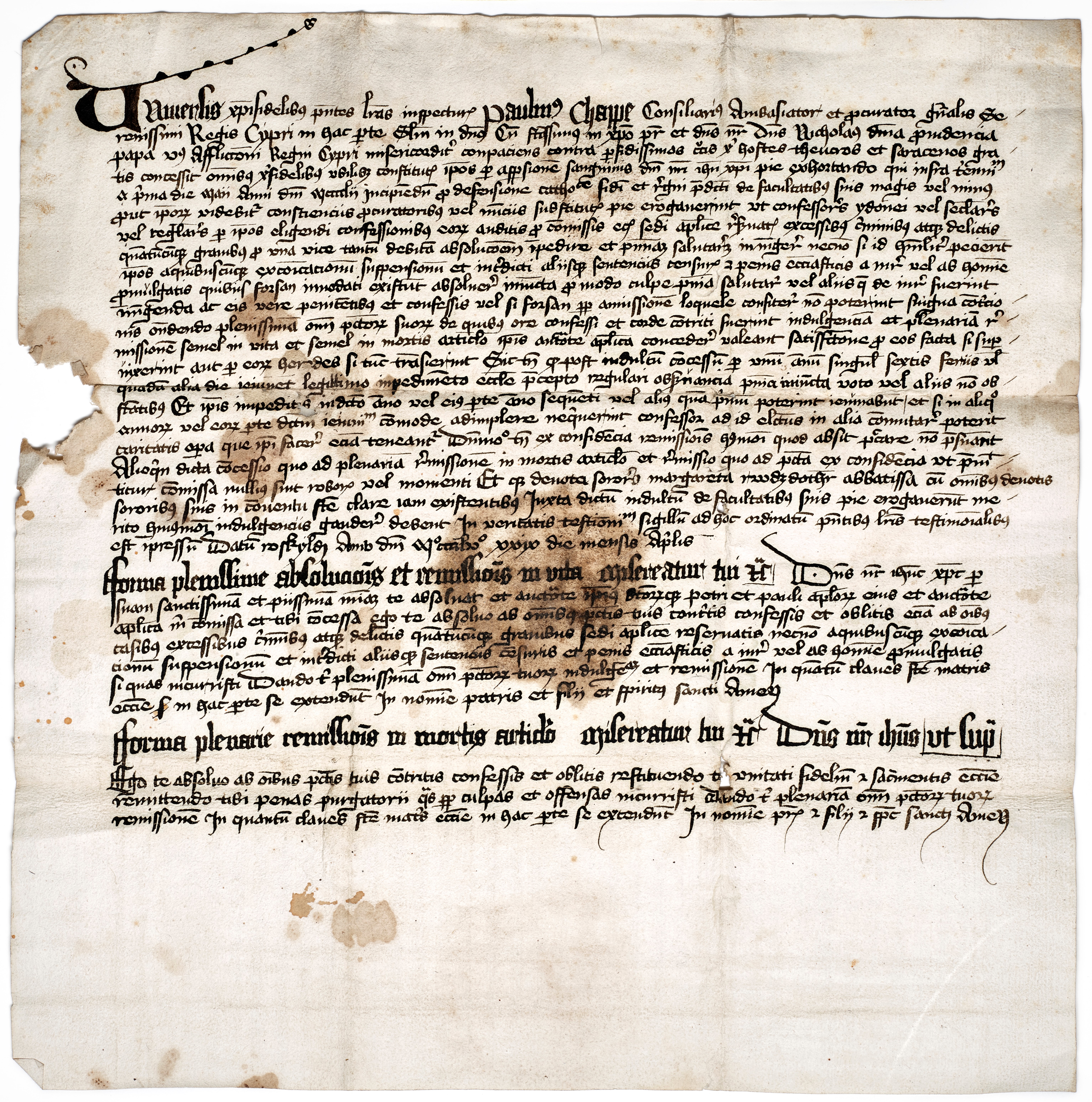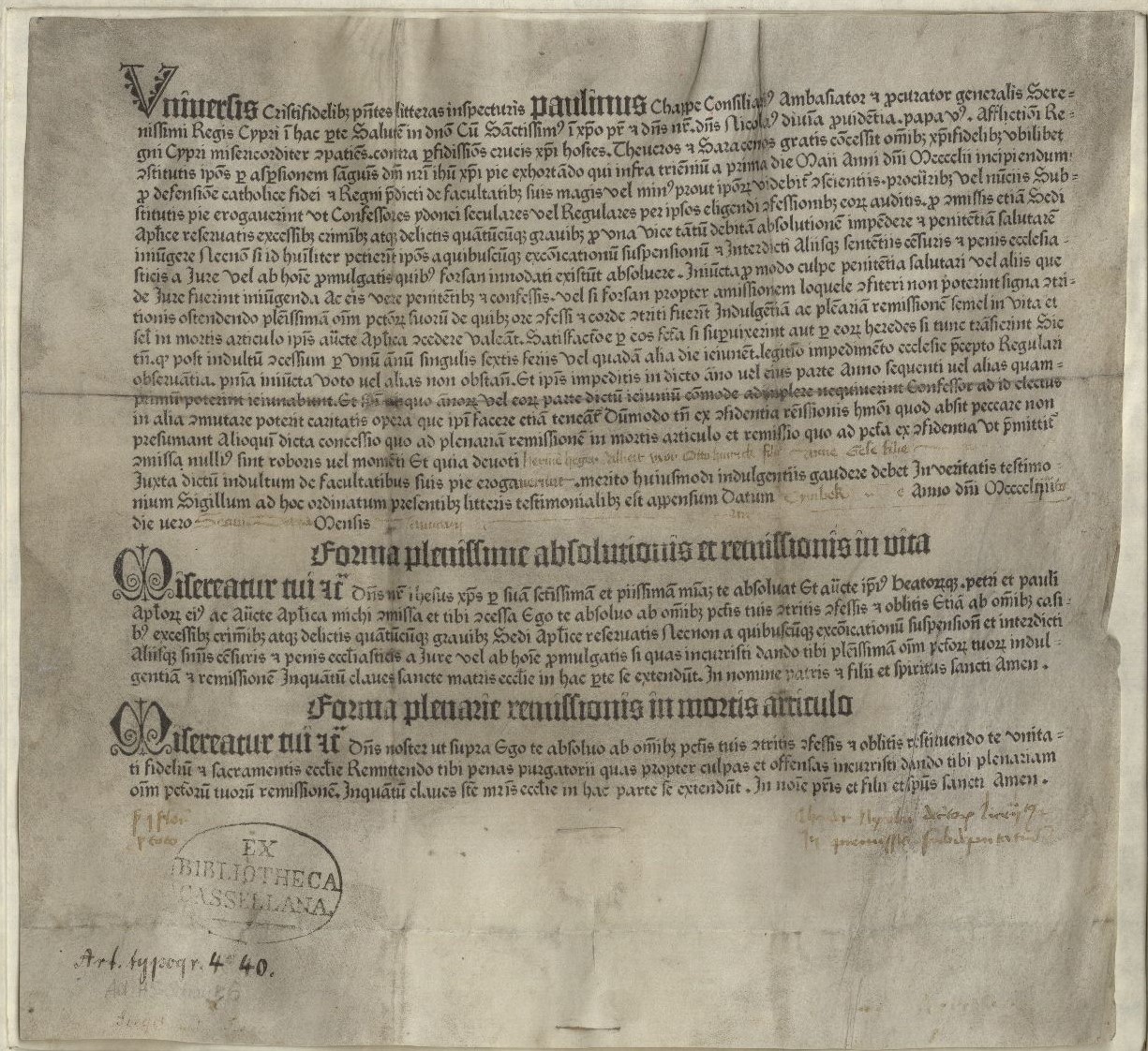Indulgences for nuns in the early days of print
A handwritten letter of indulgence given to the Poor Clares of Roskilde tells the story of Gutenberg's innovation, papal intervention and the Cypriot war against the Ottoman Turks.

Tuesday, May 29, 1453 marked the end of an era in European history. The great city of Constantinople, capital of the Byzantine Empire, fell to the Sultan of the Ottoman Empire, Mehmed II, known as Mehmed the Conqueror. The city took on a new name — Istanbul — as it became the capital of the Muslim empire. Christian Byzantium was no more.
The Ottoman Empire had already expanded to cover a vast territory in Anatolia (modern-day Turkey) and the Balkans in the fourteenth century and posed a real threat to Western Christianity. Wars against the Ottoman Turks were viewed in Christian Europe as a continuation of the holy wars known as the Crusades. The Ottoman Empire was not merely a threat to the various kingdoms of Europe — it was a threat to Christendom itself.
It was already clear when Mehmed took the throne in 1451 that he had his sights set on expanding his territory. The Kingdom of Cyprus, together with the island of Rhodes, being at the southeasternmost reaches of Christendom, were especially in the line of fire. The Cypriot king, John II (r. 1432-1458), did not have the resources to hold back the entirety of the Ottoman Empire. Fortunately for King John, he did have the support of the most powerful leader in Europe: the Pope.
On 12 August 1451 Pope Nicholas V (r. 1447-1455) sent a letter to the heads of state across Europe calling for military and financial support for Cyprus. Individuals could support the war effort by purchasing a sort of ‘war bond’ in the form of one of the most sought-after commodities in medieval Christian Europe, namely the reduction of punishment in the afterlife. The sale of indulgences had previously proved effective in fund-raising during the Middle Ages, such as for hospitals, cathedrals, or indeed crusades. The letter from Nicholas V established a three-year period in which a plenary indulgence would be granted for contributing to the defence of Cyprus, valid from May 1, 1452 until April 30, 1455.
Indulgences for the Poor Clares of Roskilde
In 1452 a Cypriot nobleman named Paulinus Chappe arrived in Scandinavia with a mission: to gather support for the war effort against the Turks. As an ambassador for King John II of Cyprus, Chappe was tasked with making public the letter for support issued by Nicholas V in the Northern kingdoms and Germany and to follow up by issuing indulgences to those who contributed.
Though Chappe likely did not come personally, his message reached the Poor Clares in Roskilde. Despite their name, these nuns at the St. Clare monastery were mostly wealthy noblewomen. They had also previously contributed to support the crusades. In 1437 a canon in Roskilde named Martinus Johannes (Martin Jensen) issued indulgences to the Poor Clares in response to two actions: Visiting the churches in Rome during the Year of Jubilee and supporting the crusades.
The Poor Clares in Roskilde were then the perfect candidates to help support the Cypriot king’s war against the Turks. And help they did. We don’t know how much the nuns contributed, but they did purchase the pope’s plenary indulgence in the nick of time. Conrad Winter, a sub-collector working for Chappe, issued the nuns their letter of indulgence on April 29, 1455 — the day before the sale ended.

The letter, AM Dipl. Dan. LXII, 3, is today held together with the other charters from the St. Clare monastery in the Arnamagnæan Collection. Written in Latin, the letter opens with the reason for the granting of indulgences, mentioning the struggle of the Kingdom of Cyprus against the Theucros et Saracenos (“Turks and Saracens”) and offering indulgences for a three-year period starting on the first day of May (prima die Maii), 1452. It then goes on to specifically mention the abbess and other sisters in the St. Clare monastery:
Sorore Margareta Rwdzdother abbatissa cum omnibus deuotis sororibus suis in conuentu Sancte Clare iam existentibus
Sister Margrete Rudsdatter, abbess, with all her devoted sisters now in the St. Clare monastery
This letter is the only one in the corpus of charters from the St. Clare monastery to name Margrete (Mikkelsdatter) Rud as the abbess of the monastery, though we know she had already joined the order by 1408. Her mother, the wealthy noblewoman Anna Pedersdatter, donated two properties to the monastery to support her daughter financially in a charter previously discussed in this series.
At the end of the letter are two indulgences: one for the living, and one for the dead. An enlarged title script using a Gothic bookhand (textualis) visually separates the headers of the two sets of indulgences from the remainder of the document, written in a cursive script. The same bookhand is used to highlight the first word Universis ‘to all’ and the name of the issuer, Paulinus Chappe.
AM Dipl. Dan. LXII, 3 - A copy of printed indulgences?
Chappe and his sub-collectors did not only issue handwritten letters of indulgence; they also made use of the latest technology that was revolutionizing the spread of the written word in Europe. Johannes Gutenberg’s moveable type printing allowed for written texts to be copied with much greater speed than copying by hand. In addition to the famous Gutenberg Bible, the German printer’s workshop also produced other books as well as smaller texts for distribution, such as pamphlets, tracts, advertisements and other materials, including indulgences.
In fact, the earliest piece of printed material using Gutenberg’s moveable type which can be dated exactly is a letter of indulgence. The so-called 31-Line Indulgence (named after the number of lines of printed text) survives in 46 known copies that are dated from October 22, 1454 to April 30, 1455. One of the known copies, today held at the Royal Danish Library in Copenhagen (Madsen nr. 1119), was issued by Conrad Winter on 29 April 1455, the same day as the handwritten copy for the Poor Clares.
A second edition of the letter, known as the 30-Line Indulgence, survives in seven known copies as well as two that were lost during the Second World War.
In addition to these two printed editions, which are only found in copies printed on vellum, handwritten copies on paper and vellum are also known. One of these copies is indeed the letter to the Poor Clares of Roskilde, AM Dipl. Dan. LXII, 3.
By comparing the handwritten copy in the St. Clare corpus with the printed 31-Line Indulgence, such as this one housed at the University Library of Kassel (Ink. A 5), we find the scribe has deliberately copied not only the words, but also the format or mis-en-page of the printed text. The Gothic bookhand in the written copy corresponds with a heading type in the printed edition that was made with the so-called Donatus-Kalender (DK) type, also used for the 36-Line Bible, possibly printed by Gutenberg.
Meanwhile, the printed 31-Line Indulgence leaves a blank space on line 18, where an issuer was meant to fill in the purchaser’s name and possibly other relevant information. The copy in Kassel is addressed to Hermen Hegel Alheit vxor Otto Hinrick filii Anne Gele filie in the same place we find Margrete Rud and the nuns in the St. Clare monastery mentioned in AM Dipl. Dan. LXII, 3. Another space is left blank on line 20 for the place of issue — Einbeck, Lower Saxony in the case of Kassel Ink. A 5 and Roskilde in the case of AM Dipl. Dan. LXII, 3 — and again on line 21 for the date.

The Siege of Constantinople was by no means the end of the wars between the Ottoman Empire and the Western Christendom, nor the final to have left its mark in the written material corpus of medieval Denmark. In 1480 an Ottoman fleet under the leadership of Mehmed II invaded the Greek island of Rhodes, though failed to capture the island. News of this attack spread quickly through printed media, including De obsidione et bello Rhodiano written by Guillaume Caoursin, which in 1482 was the first book to be printed in Denmark (by the printer Johan Snell in Odense). A Danish translation, Tyrkens tog til Rhodos, was printed in 1510 by Gotfred of Ghemen.
Contact
Seán
Telephone: +45 3533 7566
sean.vrieland@hum.ku.dk
Bibliography
Incunabula Short Title Catalogue. British Library.
https://data.cerl.org/istc/ic00422600
Ing, Janet (1983). The Mainz Indulgences of 1454/5: A Review of Recent Scholarship. The British Library Journal 9, pgs. 14-31.
Jensen, Janus Møller (2007). Denmark and the Crusades 1400-1650. Leiden: Brill.
Madsen, Victor (1931). Katalog over det Kongelige Biblioteks Inkunabuler 1. Bind. Copenhagen: Levin & Munksgaard.
Contribute to Manuscript of the Month
Have something to say about one or more manuscripts in the Arnamagnæn Collection? Contribute to the column Manuscript of the Month to get your research out there! Write to Seán Vrieland (sean.vrieland@hum.ku.dk) for more details.
